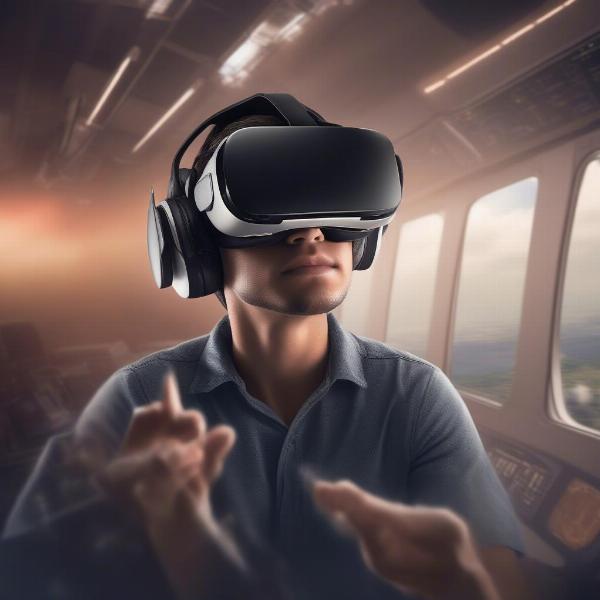The question of Who Released The First Flight Simulator Game often sparks debate among gaming historians and enthusiasts. Unraveling the history reveals a fascinating journey of innovation and technological advancements, leading to the sophisticated flight simulators we enjoy today. Let’s dive into the early days of flight simulation and discover the origins of this captivating genre.
The Dawn of Digital Flight: SubLOGIC’s Groundbreaking Contribution
While several early attempts at simulating flight existed, the widely recognized first flight simulator game is generally attributed to Bruce Artwick and his company, SubLOGIC. In 1977, Artwick developed and released “Flight Simulator 1” for the Apple II. This groundbreaking game, while rudimentary by today’s standards, offered a revolutionary experience, allowing players to take control of a simplified aircraft and navigate a basic 3D environment.
This early iteration of flight simulation was far from realistic. The graphics were simple wireframe models, and the flight dynamics were relatively basic. However, the core concept—allowing players to experience the thrill of piloting an aircraft from the comfort of their homes—was firmly established.
From Apple II to IBM PC: Expanding the Reach of Flight Simulation
Following the success of “Flight Simulator 1” on the Apple II, SubLOGIC continued to refine and expand their flight simulation software. In 1982, they released a version for the IBM PC, further broadening the reach and popularity of the genre. This version boasted improved graphics and more complex flight models, setting the stage for future advancements in flight simulation technology.
The IBM PC release marked a significant turning point, coinciding with the rising popularity of personal computers. It introduced flight simulation to a wider audience and helped solidify its place as a staple in the gaming world.
Microsoft Takes the Controls: The Rise of Microsoft Flight Simulator
In 1982, Microsoft licensed SubLOGIC’s Flight Simulator and released it as “Microsoft Flight Simulator 1.0.” This partnership proved to be a game-changer for the genre. Microsoft’s resources and marketing power propelled Flight Simulator into the mainstream, making it a household name.
Under Microsoft’s stewardship, Flight Simulator evolved rapidly. Each iteration brought significant improvements in graphics, flight physics, and realism. The series became renowned for its attention to detail, meticulously recreating aircraft and landscapes, offering an increasingly immersive flight experience.
A Legacy of Innovation: Flight Simulator’s Enduring Impact
From its humble beginnings on the Apple II, Flight Simulator has come a long way. It has inspired countless developers and spawned a dedicated community of virtual pilots. The series continues to push the boundaries of simulation technology, offering breathtakingly realistic visuals and highly accurate flight models.
“The longevity of Flight Simulator is a testament to its enduring appeal,” says Michael Duncan, a veteran game developer and simulation expert. “It has consistently adapted to technological advancements, offering an ever-evolving and immersive flight experience for generations of players.”
Beyond Entertainment: Flight Simulator’s Practical Applications
Flight Simulator’s impact extends beyond the realm of entertainment. Its realistic simulation capabilities have found practical applications in pilot training and aviation education. The software is used by flight schools and aviation enthusiasts alike to hone their skills and gain familiarity with various aircraft and flight procedures.
“Flight Simulator provides a valuable platform for aspiring pilots to learn the fundamentals of flight in a safe and controlled environment,” explains Amelia Reyes, a certified flight instructor. “It allows them to practice maneuvers and procedures without the risks associated with real-world flight.”
The Future of Flight Simulation: Virtual Reality and Beyond
The future of flight simulation is bright, with exciting advancements on the horizon. Virtual reality (VR) technology is transforming the genre, offering unprecedented levels of immersion. Haptic feedback systems and motion platforms further enhance the realism, blurring the lines between the virtual and the real.
 Flight Simulator in Virtual Reality
Flight Simulator in Virtual Reality
Conclusion
From Bruce Artwick’s initial vision to the sophisticated simulations of today, the journey of flight simulator games has been remarkable. Who released the first flight simulator game? While the answer points to SubLOGIC and their groundbreaking work, it’s the continuous evolution and dedication to realism that have solidified Flight Simulator’s legacy in the gaming world and beyond. So, buckle up and prepare for takeoff – the future of flight simulation promises even more exciting adventures in the virtual skies. Share this article with fellow aviation enthusiasts and join the discussion in the comments below!
FAQ
-
Who created the first commercially available flight simulator? Bruce Artwick and SubLOGIC are credited with creating the first commercially available flight simulator.
-
When was the first flight simulator released? The first flight simulator, “Flight Simulator 1”, was released in 1977 for the Apple II.
-
Which company currently develops Microsoft Flight Simulator? Asobo Studio currently develops Microsoft Flight Simulator.
-
Can flight simulators be used for real-world pilot training? Yes, flight simulators are often used as part of pilot training programs to familiarize students with aircraft procedures and practice maneuvers.
-
What are some of the latest advancements in flight simulation technology? Virtual reality (VR), haptic feedback, and motion platforms are some of the latest advancements enhancing the realism of flight simulation.
-
How has Flight Simulator evolved over the years? Flight Simulator has evolved significantly over the years, with improvements in graphics, flight models, and the inclusion of real-world weather and terrain data.
-
Where can I learn more about the history of flight simulation? Numerous online resources and aviation museums offer detailed information about the history of flight simulation.

